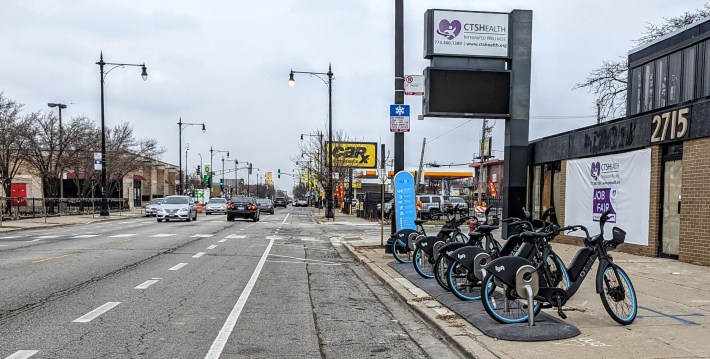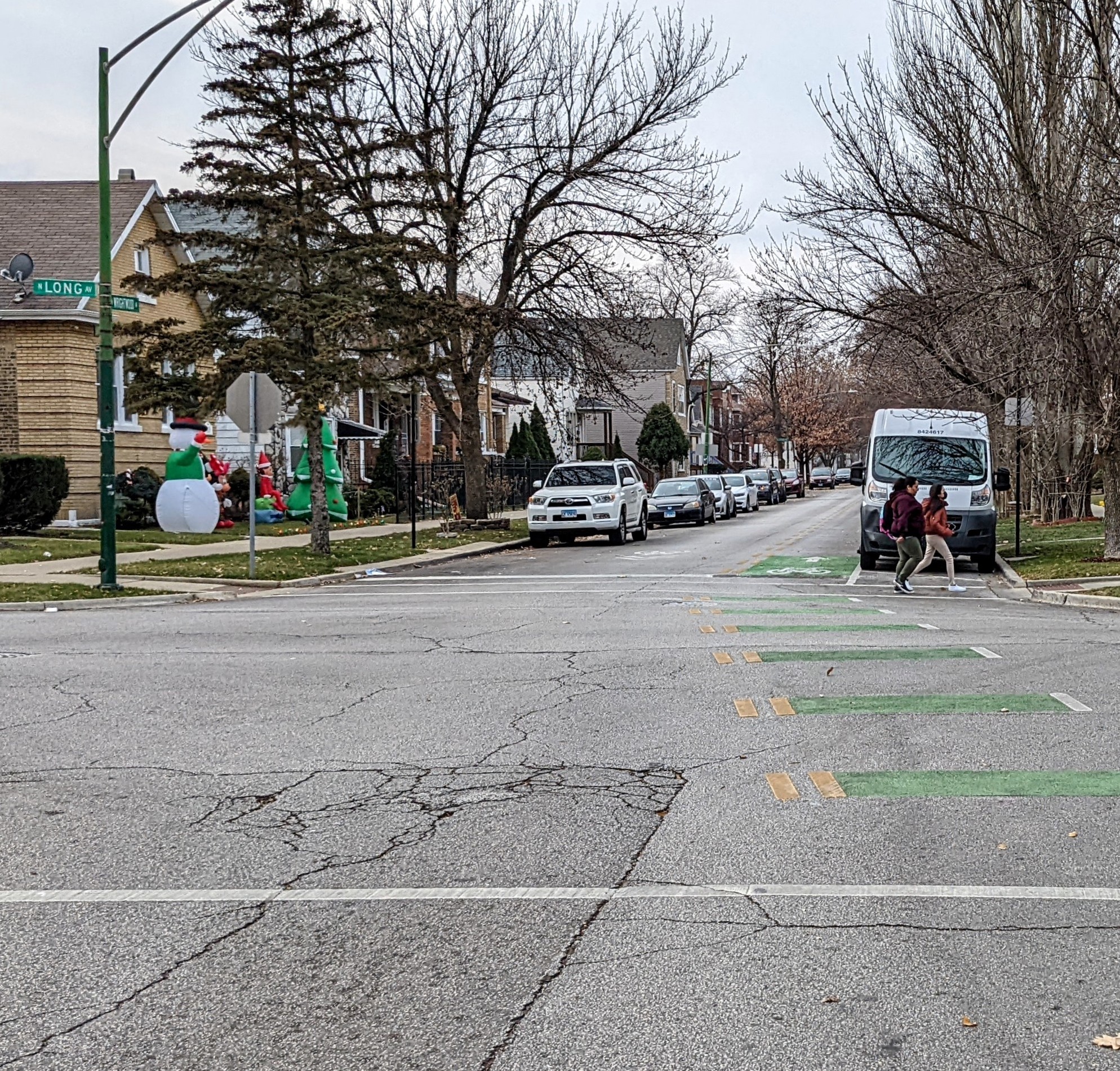Para leer este artículo en español, haga clic aquí.
The Chicago Department of Transportation is working to expand the city's bike network per CDOT's 2020 Strategic Plan for Transportation. Through the Neighborhood Bike Networks initiative, CDOT focused on building a dense bike route network within neighborhoods. By concentrating bike lanes in specific areas, the hope is that people will be able to more easily and safely access important places within their communities. The Neighborhood Bike Networks project also coincided with the Far Northwest Side Divvy Bike Share expansion. The idea is, as Divvy bikes become more available for more Chicago residents, people will be able to find bike lanes to use in their neighborhoods. This will increase people’s access to biking, and it can help people replace short neighborhood car trips with biking trips, and help provide a way for residents to connect to transit. This will help foster healthy, safe, affordable, and sustainable communities.
The Northwest Side community of Belmont Cragin became the fastest growing Latine neighborhood in Chicago due to the displacement of working-class residents from other neighborhoods by rising housing costs associated with gentrification. And for years Belmont Cragin residents, and more recently the Belmont Cragin Youth Leadership Council, have advocated for the expansion of transportation options in the neighborhood.

Belmont Cragin has no 'L' service, and until last August it had no Divvy stations. The city's 2018 Vision Zero High Crash Corridors Framework Plan identified the neighborhood as a high crash area and Fullerton Avenue as a high crash corridor. This means Belmont Cragin is one of the local communities most affected by severe traffic crashes. Local residents have long been forced to navigate unsafe streets, with limited public transportation and bike infrastructure to get around. In 2016, the Belmont Cragin Quality of Life Plan highlighted the need for Divvy access. In August 2019, the Avenues for Growth plan included the strategy of encouraging more biking, with the hope of installing a protected bike lane on Grand Avenue, a major corridor in the neighborhood.

Community engagement and collaboration are the leading principles of the Neighborhood Bike Networks project. CDOT worked with the local aldermen, community organizations, businesses, and community leaders to create a Neighborhood Task Force that engaged residents in roundtable discussions to collect feedback on new bike lanes, where bike lanes should be placed, as well as their concerns.
Major partners like the Northwest Center, formerly known as Northwest Side Housing Center, greatly contributed to the engagement process and hosted community bike rides to help get residents involved. Surveys were also distributed across the community. Divvy hosted community input meetings and provided bikes for community rides. The SAFE Ambassadors helped educate residents on the benefits of biking. However, community engagement is a difficult task that requires a lot of time, especially in dense communities with a high percentage of Spanish speakers like Belmont Cragin.
I have been biking to Belmont Cragin on average once a week for the past two years and have seen a shift in the way the streets function. It is obvious that the new painted bike lanes, pavement markings, and Divvy stations have increased residents' access to biking.
I usually enter the neighborhood via Grand Avenue, and I don't encounter any bike infrastructure until Laramie Avenue, which is halfway into the neighborhood. However, Grand in Belmont Cragin is slated to get bikeways, so this will change. So far the new bike lanes in neighborhood are paint only, white and green, with pavement markings, and wayfinding signs. I do notice cars stay further left than before, but the roadway feels cramped, and with larger vehicles passing by in the travel lane and parked cars to your right, you don't have much distance from either.
By providing input on where bike lanes should go, residents can become more acquainted with bike infrastructure. While we can hope this shifts the local culture to being more bike-friendly, paint is not protection. While drivers may become more aware of the need to watch out for and share the road with people on bikes, we are also putting people at risk by encouraging them to ride next to large vehicles without physical protection.
Safety concerns for people on bikes was the predominant theme when I asked residents and business owners what they think about the changes on large streets such as Laramie, Diversey Avenue, Belmont Avenue, as well as the and the Neighborhood Greenway routes on side streets like Wrightwood Avenue. The latter feature contraflow (“wrong way”) bike lanes that allow two-way bike traffic on one-way roads.

Linda, a Puerto Rican restaurant owner who has lived in Belmont Cragin for 22 years, said she and her neighbors were not notified of the new bike lanes. Last summer, they started seeing city workers on the streets and they wondered what existing infrastructure was going to be fixed, but instead bike lanes were striped. Linda acknowledged that space for bikes on the road is important, but added that community education is needed. "Maybe the schools should get information, [like], 'Hey you’re getting new bike lanes, these are some safety [precautions].'" Her uncle, who also lives in the neighborhood, has been riding his bike to and from work for over 10 years and drivers have struck him on two occasions. This has made Linda fearful for people on bikes, and she’s not sure if these bike lanes are enough to keep them safe.
Laura, who owns a clothing store on Laramie, echoed the safety concern. Last summer she was notified of the new bike lanes, and although she thinks bikeways on major streets are a good idea, she doesn’t like the contraflow bike lanes. She said she thinks they are dangerous because residential streets are not wide enough to support parking, driving, and bikes.
That has been a common sentiment among residents before contraflow lanes were installed in other parts of town. However, CDOT analysis of longtime Neighborhood Greenways with contraflow lanes on Berteau Avenue in Ravenswood and Uptown, and Wood Street in West Town, found that while bike traffic increased on these corridors after installation, the total number of crashes fell.
Laura's other major concern is the poor lighting on these sider streets. She spoke about her concern for pedestrians. Belmont Cragin residential streets have a lot of foot traffic, specifically children walking to school and people walking their dogs. She is afraid that if people are not paying attention, someone on a bike might hit someone walking. She does think that the bike lanes are helping and being used, especially by local youth. She knows many of them bike to school or do group rides. However, she hopes education and bike lights are provided to them, so they don’t get injured or hurt someone else.
Similarly, a local resident and college freshman named Eric said he likes and uses the new bike lanes but often sees drivers crossing into the bike lane. He said, “I wish there was more spacing between cars and bikes… but I don’t know if that’s possible.” He he added that he doesn't like the contraflow lanes. When he first saw them, he was confused about which way he should ride in the green lanes, in the direction of car traffic, or against it. (CDOT installs bike-and-arrow symbols on the lanes that are supposed to tell bike riders which direction they should be traveling in the lanes.) He added that he can tell drivers are also confused by the contraflow lanes, so he avoids biking in them.
When I spoke with other residents, they had similar thoughts: A space for bikes on the streets is important, but they worry that people are going to get hurt.
The Neighborhood Bike Network strategy, which is also being implemented in the Austin and North Lawndale communities, might bring attention to historically underserved communities and help close bikeway gaps. Divvy bikes may encourage more people to ride. However, the wariness of Belmont Cragin residents towards the contraflow lanes highlights the need for better lighting on residential streets, more education of these types of street changes, and to truly invest in infrastructure and resources that will keep vulnerable road users safe.
If the point of bike lanes is to provide a safe way to get from one place to another on city streets, are these new bikeways accomplishing that goal? If we focus our energy on creating a cohesive bikeway network, but the routes are mostly painted bike lanes that many people don't feel safe riding in, are we really helping to create safe, healthy, affordable, and sustainable communities?
CDOT names sustainability as a motivation for the neighborhood network project. In 2022 we'll get a better sense of how the new bike lanes have changed the community, and how residents have adapted to them.





